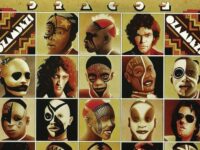Emilio Teubal’s third album (his first for Brooklyn Jazz Underground Records) is, like the prior two, a record that draws on his Argentinian roots. But this pianist, composer and bandleader doesn’t make Musica Para Un Dragon Dormido another collection of self-described “Argentinian jazz.” Here, the Argentinian element becomes a component to the mosaic of Teubal’s compositional character, a sign of maturity in a rapidly developing talent who can now pull together music from disparate sources to create persuasive, sophisticated pieces.
Teubal does play piano and some electronic keyboards, but Musica Para Un Dragon Dormido is best understood and appreciated as a composer’s record, well-executed by a sympathetic ensemble. His highly evolved pen pulls in jazz, fusion, chamber music, and yes, South American music. Structurally his songs are typically musical concept, or melodic ideas that transform into another harmonic shard, one that usually springs from the prior concept. Outwardly, songs such as “Un Simple Objeto,” “The Constant Reinventor” and “Un Dragon Dormido” have a chamber-like regimen to them, but the freedom lies not in the individual performances but rather in the compositions themselves.
The lead role in expressing the melodic parts of the songs is usually borne by multi-reedist Sam Sadigursky, but he’s often assisted by one of the very finest cellists in the world in Erik Friedlander. Moto Fukushima holds down the bottom with a six string electric bass and percussion his handled by John Hadfield and for five tracks, Satoshi Takeishi. How Teubal set up his ensemble says much about his unique approach, too: Friedlander and — usually when on clarinet — Sadigursky, will combine with the leader’s piano to provide a classical accent to songs, while Fukushima adds amplified muscle. But percussion is a large component in shaping the character of these songs, especially when Takeishi is doubled up with Hadfield; they drive the otherwise stately “Objeto,” a maintain a modern jungle groove for “Nikko” and are a source of great energy for “Milonga Para Terminar.”
The music is often idiosyncratic that they don’t play what most people consider to be jazz until the third track, “El Tema de Ludmila” a song that’s underpinned by a lithe Latin rhythm and a lithe melodic development to match, highlighted by Sadigursky’s lilting sax solo. Teubal moves over to an electric keyboard for the soft “El Acróbata,” where Friedlander and Sadigursky’s clarinet form a peaceful, melodic theme prior to Friedlander’s gorgeous cello solo. “Nikko,” which Teubael wrote with Nik Bartsch in mind, is another great track. Playing the electric keyboard with a two chord groove, Teubal deviates from Bartsch’s strategy by adding more chards, then moving on to another motif with other grooves. But like Bartsch’s Ronin, the band interplay is terrific and the players get to stretch out a little more. The wildest song, however, comes at the end. “Milonga Para Terminar” begins with a repeating figure that’s layered one musician at a time. Soon, it turns into a dense mass for a moment, then clearing out momentarily so that the percussionists can double-solo. The thematic ostinato is then played at double speed to bring the whole album to a climatic end.
With Musica Para Un Dragon Dormido, Emilio Teubal can longer be thought of as a talented Argentinian artist; it’s more appropriate to think of him as an especially talented world artist. With a little taste from Argentina.
Musica Para Un Dragon Dormido is set for release April 1, by Brooklyn Underground Jazz Records. Visit Emilio Teubal’s website for more info.
[amazon_enhanced asin=”B00BRNCF70″ /] [amazon_enhanced asin=”B002GNOPXC” /] [amazon_enhanced asin=”B000UIELIE” /] [amazon_enhanced asin=”B004UTQYUC” /] [amazon_enhanced asin=”B000U1ZJQE” /]
- Ches Smith Quartet – ‘Clone Row’ (2025) - May 30, 2025
- James Brandon Lewis Quartet – ‘Abstraction Is Deliverance’ (2025) - May 27, 2025
- Soft Machine – ‘Drop’ (1971, 2025 remaster) - May 21, 2025




